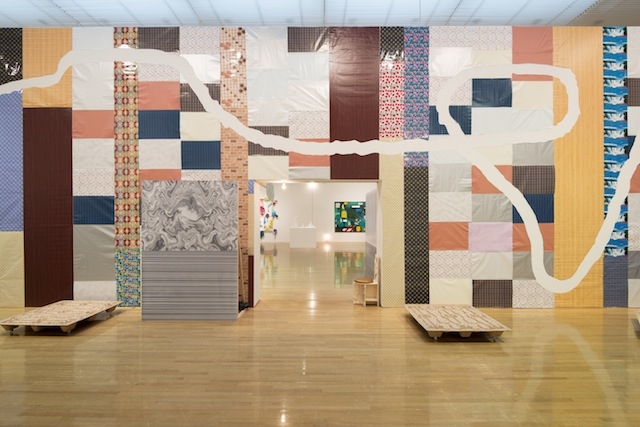17 July – 6 November, MIMOCA Marugame Genichiro-Inokuma Museum of Contemporary Art
Zones presents a thorough and valuable overview of Teppei Kaneuji’s current production, but the sheer quantity and apparent diversity of the more than 125 works on show make for a demanding experience when trying to get a sense of it all. Included here are paintings, sculpture, posters, collage pieces, furniture (made in collaboration with Shusuke Kaneuji, the artist’s father), mobiles, makeshift space dividers, videos, wood carvings, glass pieces and several wheeled pallets holding collections of brightly coloured domestic objects.
The representation of meaning through image and material seems to be a basic theme under interrogation throughout Zones, perhaps most obviously in the latest examples of Kaneuji’s White Discharge series (White Discharge (Built-up Objects/Ghost of Sculpture), 2016), for which the objects on the pallets are the starting point. On the exhibition’s opening night, participants (named in the titles of the individual works) arranged these objects in towering structures, over which a thick white liquid was poured. The end products are sculptures that retain hints of the underlying objects, while the congealed white material smothers and abstracts them. The artist’s origin story for this series tells that one day he noticed how a thick layer of snow brought valuable and worthless objects into some kind of parity. The resulting artworks propose that between liquid and solid is the space of negotiation of forms and meanings; if a form gives an object meaning, this meaning becomes confused, merged and reconstructed through the mechanism of the white liquid.
In this way it could be said that the White Discharge works are a fairly straightforward demonstration of cause and effect for the artist – a way to upset the inherent meanings of an object, while creating a new, slightly grotesque form in its dripping and smothering features.
This focus on liquid forms also occurs in the many instances of the 2016 series Ghost in the Liquid Room (Make-up Shadow) that appear throughout the museum’s spaces, featuring images of drips or smears of makeup products (or in one case molten chocolate) taken from adverts. These elements are isolated from their original context and arranged across the wall surfaces, sometimes projecting out from the wall to become structural supports for installations, or hanging as mobiles. As with White Discharge, these works seem to express a disconnection between an image, its form and any meaning it may be assumed to have.
This unsettled experience is also developed through absences, through the negative spaces of form. In a large wall-based work, The Eternal (Udon) (2016), the titular noodle form appears as a snaking line cut into the many sheets of multicoloured wrapping paper that cover the wall. The Ghost Buildings (2016) series adopts used sheets of stickers that children collect, leaving only the surrounding paper outlines as the form of the work. The artwork’s title suggests the leap of imagination that a child might make when playing, creating imaginary structures from these leftovers.
The works seen in Zones suggest certain investigations into the meaning behind the materiality of the artefacts of popular culture, be that in relation to the colourful objects in White Discharge, to advertising in the images of the makeup and chocolate, or to the cartoon-like representations of objects that are collected in seemingly arbitrary arrangements in the Games, Dance and the Constructions (2016) series. But this investigation remains on the level of the surface, arguably reflecting how these materials and images are mediated through contemporary popular culture. If such popular culture is understood as being shallow, then Kaneuji’s artworks exploit that shallowness to construct a revised view of that culture. Unfortunately that revised view remains at the level of simply making it appear strange. If shallowness means the evasion of further critique, and this is then a feature of Kaneuji’s work, it creates the lingering suspicion that this is not enough, and the works are unable to extricate themselves from the level of superficial imagery.
This article first appeared in the Autumn 2016 issue of ArtReview Asia.
